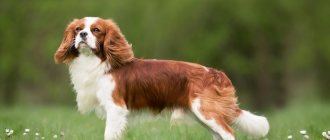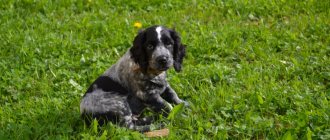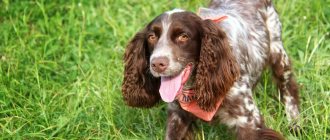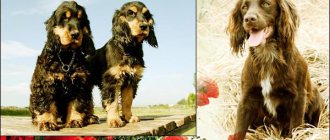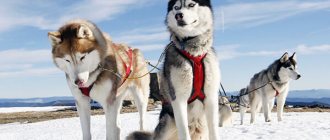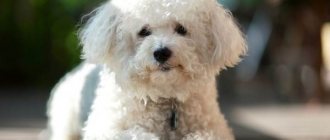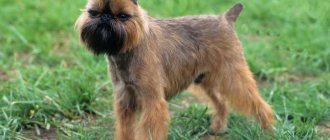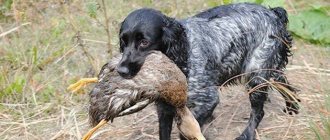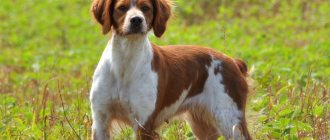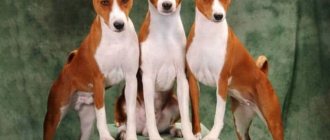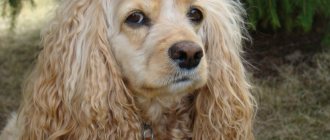The Russian spaniel is a hunting dog, a real pride of domestic dog breeders. This is the only domestic breed of gun dogs that is not recognized by the International Canine Federation, but is popular among hunters in our country and abroad. ROS (Russian Hunting Spaniel) is a special dog. It harmoniously combines: endurance, excellent working qualities, excellent physical characteristics, a gentle, kind disposition, playfulness and sociability.
Representatives of this breed help hunt feathered game and hares, serve in the police, and quickly and without errors find contraband and prohibited substances (drugs, explosives). Dogs are good for more than just work. Smart and loyal dogs make excellent companions with whom you can travel and spend active time.
We tried to collect in this material everything about Russian Spaniels (ROS), answer basic questions about the breed, and tell the main information that will be useful to the current and future owners of these dogs.
Story
The history of this young domestic breed of hunting dogs dates back to the end of the 19th century. Then the first representatives of the English Cocker Spaniel breed were brought into the country. In Russian conditions, these hunters did not receive the proper calling due to their short stature. In the conditions of Russian oak forests, stocky, short dogs experienced serious difficulties while hunting game birds.
At the beginning of the 20th century, lovers of hunting spaniels began to select for selection long-legged, tall dogs with a pronounced temperament. Such specimens were most suitable for bird hunting in domestic natural conditions. As a result of this work of breeders, by the 30s of the 20th century, a significant population of dogs had formed in the country, which were unlike any species of spaniel that existed at that time.
Purposeful work to develop and consolidate the new breed “Russian Spaniel” in the Soviet Union continued after the end of the Great Patriotic War. The goal of this difficult work was to breed a long-legged, friendly hunting dog. Specimens that were saved during the war were used for breeding, as well as different types of spaniels imported from abroad. The result of painstaking hard work was the first breed Standard, presented to the canine community in 1951. The Russian spaniel differed from the usual short cocker spaniel in size.
Work to improve the exterior and performance characteristics of the new breed was continued; for this purpose, representatives with the best field qualities were selected. The breed standard was supplemented in 1955 and 1966. Since 1972, only representatives of ROS were allowed to crossbreed; mating of these dogs with other spaniel breeds was prohibited.
Character
The Russian Spaniel has a cheerful, friendly disposition. From birth, such a dog is distinguished by its desire to bring game to its owner.
During the hunt, he discovers a bird, picks it up and, after a successful shot, brings it to the owner without damaging his teeth. In addition to poultry, this dog is used to hunt wild goats and hare.
The Russian Spaniel always tries to be close to the owner; if this is not possible, he does not take his eyes off him. Whether it's a warm house or a cold swamp, the dog is always near the owner.
Possessing excellent intuition, the spaniel can recognize people with bad intentions. He is unfriendly to such strangers and is suspicious of their actions. If this is a family friend or relative, the dog happily welcomes you and invites you to play.
For children, the Russian Spaniel is the best friend and playmate. He tolerates children's pranks. His energy reserve is so large that he can frolic with the kids for hours on end.
There is no need to leave a hunting dog with small rodents. She might mistake them for prey. He is friendly towards other pets. He can even sleep and eat together with domestic cats.
If one of the household members is in danger, the Russian spaniel turns from a cheerful playful dog into a brave defender. But it is not recommended to make him a guard dog; this can weaken his hunting qualities. Representatives of the breed rarely show aggression.
Description of the breed Russian Hunting Spaniel
A harmoniously built hunting dog with strong bones below average height - this description of the Russian Spaniel breed resembles the description of the related breed “English Cocker Spaniel”. Representatives of both species are similar, but professional hunters will never confuse these two dogs.
For those who are just getting acquainted with ROS, we have highlighted the characteristic features of the Russian Spaniel breed, by which you can easily distinguish them from Cocker Spaniels.
Similarities and differences in the description of a cocker spaniel and a Russian spaniel
The breed standards of these two varieties of dogs contain a small number of fundamental differences by which they can be distinguished from each other. These two hunters have quite a lot of similarities. Therefore, let us dwell in detail on the distinctive features:
- Representatives of the ROS breed have a longer body and legs. Cockers are more compact and shorter.
- Cocker Spaniels' ears should be set low (at eye level). In ROS, the ears are set moderately low.
- The Russian Spaniel's head is lighter than that of the AKC.
- Cockers have longer hair.
- Russians are less “shaggy”.
- The “English” have a wider muzzle and a more developed occipital protuberance.
Important: the Russian hunting spaniel and the English cocker spaniel are two independent breeds, and not different branches of one.
Related article:
Small dog breeds - top 35 breeds with photos and brief descriptions. It may also be interesting to read a list of the smallest dog breeds with photographs and a brief description of their characteristics.
Causes of premature death
The owner of a Russian spaniel must know the main reasons why his pet can die at a fairly young age:
- poor quality nutrition;
- insufficient physical activity and short walks;
- lack of vaccinations;
- untimely treatment against parasites;
- excess weight and overeating;
- hunting injuries;
- poisoning with toxic substances;
- untimely treatment.
It is important! Curious and active Russian Spaniels, unfortunately, often get hit by cars. To avoid a tragic situation in the city, representatives of the breed are only walked on a leash.
Breed standard Russian hunting spaniel
The official breed standard ROS is adopted only at the national level in Russia. Today, the edition approved by the decision of the Presidium of SOKO RKF (Union of Public Cynological Organizations - Russian Cynological Federation) dated January 29, 2020 is used. Until 2022, the edition of the Russian Spaniel Breed Standard dated April 19, 2012 was in effect.
ROS was introduced to the foreign community in the 90s of the last century. The International Cynological Federation still does not recognize the young Russian breed; in FCI documents it is classified as “outside the FCI classification”.
Outside the Russian Federation, the breed is recognized by only a few clubs and organizations:
- APRI = American Pet Registry, Inc.;
- CKC = Continental Kennel Club;
- DRA = Dog Registry of America, Inc.;
- FIC = Federation of International Cynologists;
- NAKC = North American Kennel Club;
- RSC = Russian Spaniel Club;
- UFC = Universal Kennel Club International.
According to the RKF breed standard:
- Body type. Strong, moderately squat. Dry type of construction.
- Rib cage. Long, moderate width and depth. The shape is oval. False ribs are developed.
- Back. Strong, straight. With well developed muscles.
- Limbs. Muscular. Direct. Parallel. The angle between the shoulders and shoulder blades is almost 100°. The angles of the hock joints are well defined. Elbows point straight back.
- Paws. The shape is round. Arched. The fingers are tightly clenched. The color of claws and pads is not established by the standard. There is thick fur between the toes.
- Gait. With free movements. Running - easy gallop.
- Neck. The length of the neck is commensurate with the length of the head. The position is average. The transition to the shoulders is smooth. The muscles are well developed.
- Head. Length – moderate. Dry.
- Muzzle. Wide. Tapers towards the nose. Equal to the length of the cranial part of the head.
- Nose. Wide. Nostrils are open. Nose - black and brown colors are allowed.
- Bite. Scissor-shaped. The teeth are strong, well developed, and fit tightly together. White color.
- Ears. Wide. Landing is above eye level. Long, hanging, mobile. Should fit snugly to the cheekbones. The bottom shape is round. Covered with silky wavy fur.
- Eyes. The shape is oval. Color ranges from light brown to dark brown.
- Tail. Mobile, well covered with hair. Harmoniously continues the top line. Thick at the base. Tapers towards the tip. According to the breed standard, docking of ½ length is allowed.
- Coat. The outer hair is of moderate length. Can be straight or wavy.
- Color of the Russian hunting spaniel. The new standard distinguishes two varieties: piebald and spotted colors and solid colors. The first type can be with or without specks (sparse or dense). In the second type, minor white markings are allowed on the dog’s throat, chest and paws. More information about colors in the subsection “Photos of colors”.
- Height at the withers of a Russian spaniel. In the new edition: height of males – 40-45 cm; females – 38-43 cm.
- How much does a Russian hunting spaniel weigh? The breed standard does not specify weight. The average weight of ROS is from 13 to 16 kg.
- How long does a Russian hunting spaniel live? Average life expectancy is 14 -15 years. They can live up to 20 years.
English springer
The breed can be called the progenitor of all living Spaniels - the most ancient companion and hunter of the English nobility is the Springer. A large dog, reaches 46-56 cm at the withers and weighs up to 30 kg. Stately, muscular, strong, but graceful in movement, light and fast . Dogs were especially popular during the Renaissance: great artists painted them on canvas and described them in novels.
Currently, two types of Springers are bred: working hunters and show decorative dogs. They are not very different in appearance, but have different abilities and degrees of development of instincts.
A good family pet: kind, loyal, active, devoted . The best friend for children, a partner for running and playing. Suitable for active people with free time for walking and hunting.
Springers cannot be left alone for a long time: they begin to whine, bark, and destroy everything around them. Recently, there has been a tendency towards increased incidence of rage syndrome. This is a neurological disease related to epilepsy. At the moment of an attack, the dog does not distinguish between commands and does not understand where it is, and attacks its owners for no reason.
Characteristics of the Russian Hunting Spaniel breed
These dogs were originally bred for hunting, so the main traits inherent in ROS are: endurance, excellent sense of smell, tirelessness, and perseverance. The character inherent in nature of the Russian hunting spaniel is best revealed during the hunt. There they patiently track down game, decisively rush into the water and jump into the swamp slush for prey, and boldly make their way through thickets of nettles and burdocks. Nothing can stop the hunting dogs.
A magical transformation happens to Russian spaniels when they return from hunting. At home, these tireless active and fearless hunters become ordinary sofa dogs. They behave good-naturedly and gently with their household members, and welcome guests. Ready to be close to the owner, no matter what he does. This may be surprising, but this is how most owners of dogs of this breed speak about their pets.
Dogs are non-conflict, non-aggressive, absolutely good-natured and generous towards children. They tolerate small children's pranks and become loyal friends for little family members. Get along with other dogs and cats. Caution should be exercised only by families with small pets: hamsters, rats, guinea pigs. The hunter's instinct can take over the dog, this can lead to dire consequences.
Adult dogs retain puppy playfulness and do not lose interest in various types of entertainment. The most favorite pastimes of this active dog are searching for any objects and fetching balls. Dogs need to be played with daily to avoid unwanted destructive behavior. Animals can compensate for the lack of play with chewed shoes.
Signs of aging
Dog experts believe that the Russian spaniel is fully formed by the age of 3–4 years. A dog of this age should produce healthy puppies, participate in exhibitions and competitions, go hunting and be active and healthy. The duration of this period is approximately 4 years, and after 7 years, spaniels gradually begin to age.
The main signs of aging of Russian spaniels:
- Coarse, dull, bald coat.
- Decreased hearing, vision and smell.
- Slowing down the reaction rate.
- Increased sensitivity to cold.
- Preference for sleep over play.
- Replacement of part of muscle tissue with fat.
- Unsteady and slow gait.
The owner of a Russian spaniel must understand from the moment of purchase that he takes responsibility for the life of the pet. The necessary care, love and care of the owner will make both the dog and the person happy. In addition, these are important components of a long and healthy dog's life.
Care and maintenance of the Russian Spaniel breed
The ideal place to keep ROS is a country house in the countryside with a spacious yard and a forest nearby. This is a real paradise for a hunting dog, who could realize his scouting instincts there, enjoy a variety of aromas, and unity with nature.
But in this dog paradise there is no place for a rotten kennel, an iron chain and a cramped enclosure. Spaniels can rest in the yard in warm, dry weather; in the summer they will not refuse to spend the night under a canopy. But they are not suitable for year-round outdoor use. A spaniel's place is in the house, next to its beloved owner.
A Russian Spaniel hunting dog can also be kept in city apartments. The main condition for such urban housing is sufficient walking, regular taking of the animal to nature and hunting. If you have a dog that is not trained to hunt, he also needs to be taken out of town for walks. You can take your pets with you on hiking trips through the forest. The compact dog fits perfectly into a regular backpack.
Important : if you compare how long Russian hunting spaniels live and companion dogs that do not take part in hunting, we can conclude that hunting has a positive effect on life expectancy.
Related article:
Nickname for a spaniel boy or girl - examples of names, tips, hunting nicknames . Not only does the puppy need to be selected according to many parameters, but it also needs to be named correctly. Read in a separate article about naming options for a spaniel puppy.
Carrying out the operation
Since a spaniel with an undocked tail is not suitable for hunting, many breeders perform docking surgery on their spaniel puppies themselves. If the dog owner does not have the appropriate experience, then it is better to entrust the surgical operation to an experienced veterinarian. It uses a blade, a scalpel or surgical scissors, as well as an antiseptic substance.
At 3-5 days of age, the spaniel is the size of a palm. The puppy is placed belly down on the table, then pressed lightly. A tourniquet is applied to the tail. Next, the animal is fixed, the skin on the tail is pulled to the base, 4-5 vertebrae are counted, then cut off in one motion using a sterile instrument.
Next, the puppy is placed on its back and the cut is treated with an antiseptic. The baby is returned to his mother, who licks his wounds. The procedure lasts no more than 30 minutes, including preliminary preparation of instruments.
Older dogs must be given anesthesia: general or local anesthesia. Next, stitches are placed on the wound using self-absorbing threads.
How to care for a Russian Spaniel
The dog's luxurious coat requires regular and thorough care. She is combed 1-2 times a week. First, use a natural wide-tooth comb to comb out debris, then use a brush or fine-toothed comb to add shine to the coat. Brushing the fur not only removes dirt, dandruff, and dust, but also stimulates blood flow to the skin surfaces. Puppies need to be taught this mandatory procedure from a very early age, so that later they do not avoid it and calmly allow themselves to be brushed.
But bathing dogs completely with detergents and hygiene products is allowed 2-3 times a year. There is no need to carry out this procedure more often for preventive purposes. Extraordinary bathing is allowed only if necessary, if the animal has smeared itself in something. But even in such cases, it is better to wash the dog partially, without completely immersing it in water. Too frequent bathing washes away the protective oil layer from the coat.
Dogs of this breed get two types of haircuts:
- Hygienic. Held once every two weeks. The hair is trimmed around the fingers, in the vicinity of the pads, around the anus, near the auditory openings. The mats in the groin area are trimmed.
- Full. Professional haircut. It is carried out at intervals of 2-3 months in grooming salons.
The claws of spaniels that constantly walk on hard ground can wear down on their own. The owner must control the length of the claws, preventing excessive growth. Too long claws can dig into the animal's finger pad - this causes pain and discomfort to the pet.
It can also cause your dog to become lame. The claws are trimmed with a special nail clipper. The guillotine design is best suited for this. Trimming with simple scissors is unacceptable - this can lead to separation of the claws. It is allowed to use a file for this manipulation.
Your pet's large floppy ears require special attention. This signature POC needs daily inspection. During the inspection, contamination and traces of possible infections are revealed. The auricle is cleaned from the inside of dirt and wax with a damp swab or cotton pad soaked in warm boiling water. Do this as needed or 1-2 times a month.
Some publications recommend airing floppy ears. The advice is controversial, but not without meaning. This design of the ears, due to poor ventilation, creates an ideal environment for the growth and development of various microorganisms and mites. To ventilate your pet’s ears, you can wave them a little, like the wings of a butterfly, or secure the ears with a soft elastic band or a special clip above the dog’s head.
Caring for a Russian Spaniel puppy and an adult animal includes eye examination and cleaning. A healthy animal's eyes should be clean, without signs of souring or tear tracks. If something similar is detected in a dog, it should be shown to a veterinarian. For prevention, it is enough to wash your eyes with a cotton pad soaked in a decoction of chamomile or a weak tea solution.
Strong and healthy teeth are the pride of a hunting dog and a guarantee of his health. From puppyhood, dogs are taught to brush their teeth - this prevents the formation of tartar and gets rid of plaque on the teeth. Cleaning is carried out with a special toothbrush using toothpaste from a pet store. It is necessary to give preference to products without a strong smell and taste. At the end of cleaning, wipe the teeth with a soft cloth or dry cotton swab.
Important: it is necessary to ensure that the dog does not swallow the toothpaste - this can cause gastrointestinal upset.
Health of the Russian Spaniel dog breed
The breed itself is considered quite healthy. With proper maintenance, proper care, adherence to the schedule of vaccinations and antiparasitic treatment, and a nutritious balanced diet, health problems rarely arise.
Genetic pathologies:
- cryptorchidism;
- hip dysplasia.
Other diseases to which the breed is prone:
- obesity;
- otitis;
- food allergy.
Training dogs of the Russian hunting spaniel breed
We have already written that this breed is smart and easy to train. Puppy training begins from the first day of life in a new home. The owner must immediately show the new pet who is boss in the house. The training program is built depending on whether the dog will be used for hunting or will be a companion animal.
Training for hunting
Spaniels are hunting dogs with well-developed hunting instincts. During the hunt, they must go ahead of the hunter, find and flush out the game. They work without a stand, so the dog owner is in for a surprise effect. The second job function is to bring and serve the hunted prey to the hunter. Properly trained dogs do this without prodding from humans, they are excellent swimmers, and are not afraid to jump into ponds and swamps after birds.
Pets begin to be trained for hunting from an early age. The main command that working dogs are taught is: “Give it!” Active puppies are happy to bring and give to the owner a ball, a stick, or a bird's wing. The commands required for a hunting dog are: “Come to me!”, “You can’t!”, “Place!”, “Take it!” It is best to conduct training with a canine specialist. Energetic pets quickly remember commands, carry them out with enthusiasm, easily and naturally.
Raising pets
The main thing that needs to be taught to a companion dog is obedience. Hunting dog breeds, such as spaniels, may run away during a walk due to a sudden surge of hunting instinct. It is not uncommon for pets to get lost because of this. Another important and necessary command that should be one of the first to learn is “Fu!” or “You can’t!” This breed is a glutton that strives to pick up something on the street and eat it.
Top nicknames
Spaniel hunting dogs respond well to short and sonorous nicknames. During walks, dogs run far away and simply won’t hear another name. Boys are often called:
- Barney;
- Geyser;
- Jerry;
- Carat;
- Kras;
- Locky;
- Noah;
- Radar;
- Lb;
- Eric.
A spaniel girl can be called:
- Boni;
- Storm;
- Dolly;
- Irma;
- Weasel;
- Mila;
- Nika;
- Taurus;
- Sheri;
- Yuda.
You should avoid long and unpronounceable names, as well as nicknames that sound like commands.
What to feed
The owner chooses the type of food (natural, industrial) for his pet. Both varieties are suitable; each owner decides what is more acceptable and convenient for him. The main thing is to monitor the volume of daily portions and avoid overeating.
Industrial feed
The daily ration is calculated using the formula: 40 g. feed for 1 kg. live weight.
Recommended brands of food:
- Acana Adult Dog Heritag;
- Orijen Adult Dog;
- Bosch Light;
- Brit Care;
- Royal Canin Adult Cocker.
Natural nutrition
Daily norm: from 30 to 60 g. per kilogram of animal weight.
A dog's diet should include:
- lean meat;
- beef tripe;
- lean sea fish fillet;
- quail egg;
- vegetables, greens;
- dairy products;
- bran;
- Brewer's yeast;
- porridge (oatmeal, buckwheat, rice).
Important: game caught during hunting is not included in the diet, so that the dog does not want to spoil the prey.
Nutritional Features
Spaniels are unpretentious in nutrition: they willingly eat both home-cooked food and ready-made food. At the same time, it is very important that the food is of high quality and complete.
If it is ready-made dry food, then it must be at least premium class and at the same time appropriate for the size, age, physical condition and activity of the pet..
With natural feeding, approximately 50% of the diet should consist of lean muscle meat and offal, to which are added porridge, boiled or raw vegetables, fermented milk products, as well as vitamins and minerals.
Considering that most spaniels are prone to overeating, you need to make sure that the pet receives only its portion.
You should not supplement him between feedings, or allow him to beg for food near the table or look for “supplements” to his diet on the street.
Pros and cons of the Russian Spaniel breed
The characteristics of any breed have pros and cons; the Russian spaniel also has disadvantages and advantages.
Pros of ROS:
- Excellent hunting characteristics.
- Friendly disposition, lack of aggression.
- Devotion.
- Fearlessness.
- Suitable for keeping in a city apartment.
- The fur does not have the characteristic dog smell.
- Perky disposition, playfulness.
- Ability to get along with children and pets.
Cons of ROS:
- They shed heavily.
- They may overeat.
- Requires long active walking.
- Tendency to food allergies.
German Wachtelhund
A medium-sized gun dog (up to 50 cm at the withers) . The name translates as “quail”, the main working function of the dog is to lift the bird from the ground to the wing. The animals are stately, beautiful, with a long neck, a typical wedge-shaped muzzle and wavy brown fur.
These are working dogs that need physical and mental exercise. They will not be able to live locked up, not being able to run around enough. If the dog is kept in an apartment, he will need at least 4 hours a day for walking.
The owner needs to prove his leadership to the pet, then the Wachtelhund will trust and begin to obey. In general, dogs are friendly, flexible, and affectionate . The average cost of the breed is 25-40 thousand rubles.
Photos of colors of the Russian Hunting Spaniel breed
The breed standard specifies two types: solid, piebald and spotted. Minor white markings on the dog’s paws, chest and throat are allowed in solid colors (red spaniel, brown spaniel, black spaniel), and in the second type of color there may be specks of varying intensity.
- Black Russian Spaniel
- Brown and tan
- Black and tan
- Black and white Russian spaniel
- Red and white
- Brown-white
- Black and white with tan
- Brown-white and tan
Purpose of the operation
Why do spaniels have their tail docked nowadays? This is a kind of tradition that has developed for this breed. Breeders and owners perform such actions for aesthetic purposes. Proponents of docking are convinced that the selection of the breed did not include the presence of a tail, so it not only has a strange appearance, but also upsets the balance and prevents the dog from moving fully.
Opponents of this procedure consider the tail as a “rudder”, a means of communication. In Australia, as well as in many European countries, such a procedure is considered inhumane and is prohibited. Spaniels with a natural appearance become winners at international exhibitions. In our country, the question of whether a spaniel will have a tail is decided by the owner of the dog.
If the dog is intended for hunting, then tail docking is a justified measure. According to the results of statistical studies conducted in European countries, it turned out that more than half of the dogs of this breed receive tail injuries during the hunting season.
The domestic spaniel with a tail is a common sight in modern Europe. There are no significant differences in injury rates between domestic dogs with undocked and docked tails. The doctor may prescribe amputation in case of serious injury: burns, fractures, frostbite, oncology.
Where to buy a puppy
When choosing a puppy, give preference to club pets so as not to purchase a mixed breed or a defective animal. Carefully study all documents: pedigree, field diplomas of parents, results of genetic tests.
Kennels of the Russian hunting spaniel:
- Shchelkovo ROSy, Moscow – russianspaniel.ru;
- Russian spaniels of St. Petersburg, St. Petersburg – russianspaniel-spb.com;
- Spaniels of the Volga region, Kazan – spaniel-volga.ru.
Complications
Among the consequences that may appear after cupping are wound infection, scarring of the cut made, and bleeding. Such consequences are typical for adult dogs. In order to prevent such problems, it is better to carry out the operation in a good veterinary clinic. Infection occurs when sterile conditions are violated. If the operated dog develops complications, it is necessary to contact a veterinary clinic.
Owner reviews
Below we have given a couple of reviews from owners of the Russian Spaniel dog breed, which we received in personal messages. If you found these reviews useful, write your review in the special feedback field below and share your experience. After all, a live review from a spaniel owner is very valuable for people considering purchasing a puppy of this breed, who would like to learn more about the wonderful Russian Spaniel dog breed.
Nikolay: “When I was going to get a dog, I had a choice of two breeds: Russian black spaniel and cocker. I doubted that I needed a dog for hunting and fishing. Having studied almost everything about Russian spaniels on the Internet, I gave preference to the ROS puppy. And I was not mistaken. This is an unusual dog. She is at the same time calm at home, active and inquisitive in the forest. It is important to let her express this activity to the fullest. The spaniel is cramped in the courtyard of a multi-storey building; he needs a lot of free space.”
Svetlana: “My brother the hunter has a black spaniel. This is a tireless dog, an energizer battery. Curious, inquisitive, a real explorer! One can envy her energy. The children adore her, she answers them in kind. It’s always fun and interesting with her.”
